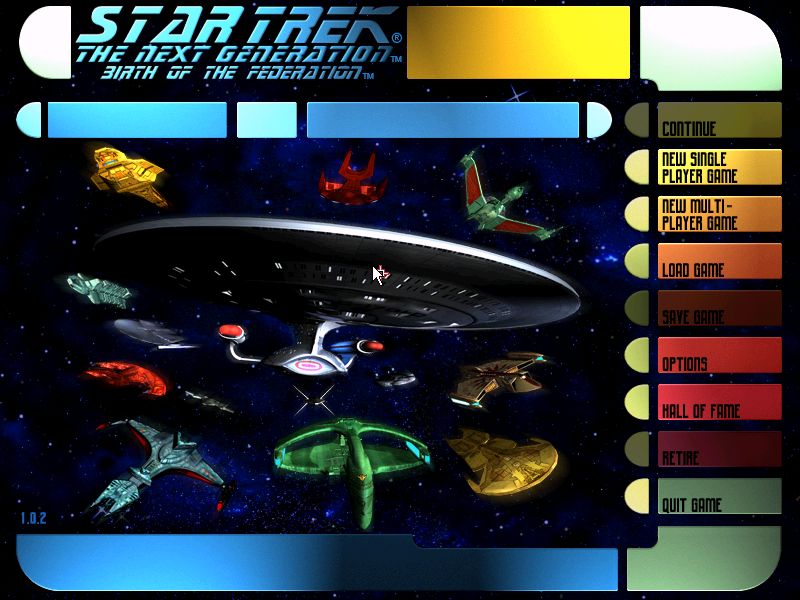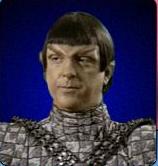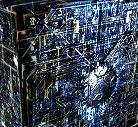Part 68: Turn 201
TURN 201
Most of our colonies are building new intel centers. Volon is still producing Birds of Prey. Qo'nos and Yridia are no longer building because their populations are staffing intel centers and labs.

The Ferengi buildup on Deinonychus reaches nearly 40 ships. There is much debate in the High Command about our future. Some believe we should plan to war against the Ferengi, while others believe we stand a better chance at actually conquering the Romulans. Few seriously consider the Federation or the Cardassians as our next target, since those territories are too distant and conquests there would not be contiguous with our empire.
The Romulan argument goes something like this: The Ferengi are too powerful to attack, while the Romulans are by far the weakest empire. The Romulans have been further weakened by their war with the Federation. If either the Cardassians or Federation go to war against the Romulans again, they could even assist us. Furthermore, it's always nice to knock off an enemy who has been sabotaging you with spies.

TURN 202. But Vice-Chancellor Martok is far more impressed by the arguments of Worf, who leads the defense operations on Shelia. He believes we should prepare for aggressive war against the Ferengi.
"For the moment, our southern border seems defensible enough. The Romulans appear too weak to attack us, and any effort by the Federation or Cardassians against us requires Romulan affiliation. By contrast, the Ferengi have a fleet near our core, like a bat'leth aimed at our neck. The Ferengi will always be our biggest threat.
"Should we attack the Romulans, we will give up the cloaking advantage of our Birds of Prey, since Romulan warships are also cloaked. As we gain more territory to the south, we will become increasingly vulnerable to counter-invasion by Cardassians or the Federation. And the more resources we pour into the south, the less we will be able defend against the Ferengi.
"Attacking the Ferengi does not appear to put us at any disadvantage in the south, where we are safe for the time being. The Ferengi are the more powerful opponent by far, but that means our victories will be all the more glorious."

TURN 204. Perhaps seeking refuge in case of renewed war with the Feds, the Romulans have stored their noncombatant ships at the Starbase on Qo'nos. Would they do this if they believed war against us was imminent? Perhaps their spies have been following the debate, which leans heavily toward an anti-Ferengi posture.

TURN 205. The only way the other empires seem willing to break out of the galactic deadlock is to have us fight for them.

OUr intel power nears 4,000 points. We have been able to stop Cardassian sabotage for some time. Not for lack of trying on their part, as the reports show.

We'll need to colonize all of those little systems within our borders.

TURN 208. The best of the remaining is the Persephone system, next door to Qo'nos.

Pollux, just north of Yridia, will also add a few more taxpayers to our empire.

TURN 209. If we are going to launch a war against the Ferengi, Shelia will undoubtedly be the first system the Ferengi counterattack. It's rare to see a system with more than 10 Batteries, but we've more than doubled that. "Put your backs into it!" Worf roars at the Sheliak. "If you wanted to slack off, you should have remained under Ferengi rule!"

TURN 211. In the far northeast, the Volchok colony was grown well. It has over 500 industry points and its natural energy fuels a new scanner. Despite all of the scanners we've added lately, we still cannot detect the Romulan warships. Volchok will have its factories upgraded one more time, at which point it will be ready to churn out a lot of new buildings and maybe some ships in the future.

TURN 212. Domestic terrorists pick up the slack for the captured Cardassian spies.

...But maybe they don't need the help. This is why we must continually build more intel strength. The Cardassians' intel power is either growing or they are devoting more of it against us.

TURN 213. Klingon science makes another breakthrough. It would allow us to upgrade factories to level 8. Our most advanced factories are only level 6, and are on Volon. We can't take any 20-turn breaks for upgrading factories.

When looking around the galaxy at nearby uninhabited systems, there are some attractive ones in unclaimed space. Fahleena, New Halana, and Merak are among them. Even Nelvana could be included in this category. But as the Federation Heavy Cruiser task force on Fahleena demonstrates, any move to the south would put us at greater risk.

TURN 214. Our non-aggression treaty with the Feds has expired. They're the only empire that doesn't seem to want peace with us very much.

TURN 216. Improved scan strength has allowed us to see a little further behind Ferengi lines. Military experts are not pleased when they hear that the Ferengi have invented the Marauder II. These ships have 740 shield hit points--far more than even a Starbase. There is a thin silver lining to this news, however. The Ferengi cannot invent any more advanced ships. From this point forward, we will be catching up with them scientifically. We have an incentive to bide our time as much as possible.

TURN 217. We hold 13 systems, the Federation-Cardassian alliance has 14, and the Ferengi have 16. The Romulans are still stuck at 5; for some reason they haven't colonized Mintaka, which is in their territory. Perhaps they're trying to be sensitive. To most Klingons, Mintaka is sacred ground.

TURN 220. Worf is well pleased. Shelia has constructed an absolutely insane 31 Orbital Batteries. In a demonstration, Worf shows that all of them could be powered at once, thanks to all of the power plants the Ferengi built here. Obviously any war with the Ferengi should incorporate a strategy using Shelia as a sacrificial lamb. For now, the Batteries will be idle. We have no factories on Shelia, but we can buy a few low-level intel centers.

TURN 224. Volon will take a 6-turn break from producing Birds of Prey in order to upgrade its small number of intel centers and labs to level 7 and 6, respectively.

The pride of the Klingon empire: 14 Birds of Prey. Most of them are fairly well-trained, thanks to the Klingon academy on Volon and the expedition through Federation space we took earlier.

TURN 225. We detect the intergalactic Crystalline Entity, a being notorious for bombing planets. It looks like it's headed toward us. We will dispatch a group of Birds to kill it before it can cause any trouble.

TURN 226. We leveled-up in computer tech. We can upgrade our scanners one more step, but isolinear scanners require 150 energy, so we'll hold off on that until the Romulans turn hostile. We are one breakthrough away from upgrading our Starbases.

TURN 227. The Sheliak are going to have rough lives. The Ferengi are still at peace with us, but 60 million people die from a comet.

TURN 229. The Crystalline Entity evaded us for awhile, but 8 of our ships have found their prey.

It is a bizarre form of life, supposedly capable of mass destruction. Our ships decloak and kill it immediately. Our warriors are pleased by the victory. This galaxy belongs to bipeds.

President Picard sends a terse message to us upon hearing the news: "The Crystalline Entity had as much right to be here as we do." But he might not say that if the monster were creeping through his own empire. Our Birds fly back to Volon to resume training.

TURN 232. We receive bone-chilling news from Volchok, which had been a rising star among our colonies: Its sun has swallowed the whole system. Everyone is dead. Everything built on Volchok is gone.

It gets worse. All of the planets are gone. Volchok can no longer host a colony. And just after we had finished upgrading the factories! Our scientist is asked to explain this terrifying phenomenon. Apparently any red sun can go nova, wiping out all life on the system forever. It's only a matter of time.
All eyes turn to Volon. It is our most populous system. It also has a red sun. If it goes nova, the empire will lose its only dedicated ship-building center, along with all of Volon's income, research, intel, and trade routes. Time may not be on our side after all.